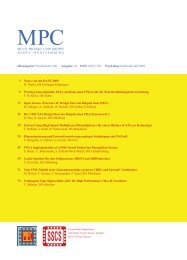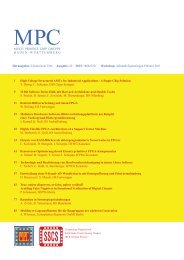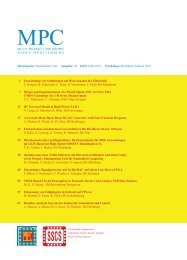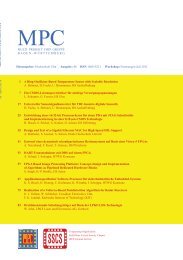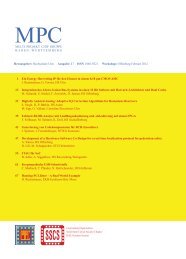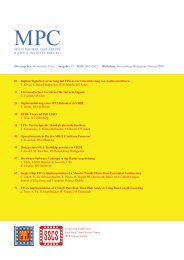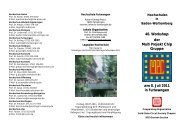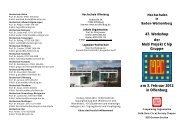[Geben Sie hier die Überschrift ein] - MPC
[Geben Sie hier die Überschrift ein] - MPC
[Geben Sie hier die Überschrift ein] - MPC
- TAGS
- mpc.belwue.de
Sie wollen auch ein ePaper? Erhöhen Sie die Reichweite Ihrer Titel.
YUMPU macht aus Druck-PDFs automatisch weboptimierte ePaper, die Google liebt.
<strong>MPC</strong>-WORKSHOP JULI 2012<br />
Measurement Unit for Energy Efficient<br />
M2M Mobile Communication<br />
Abstract—Machine-to-machine communication is<br />
continuously extending to new application fields.<br />
Especially smart metering has the potential to become<br />
the first really large-scale M2M application.<br />
Although in the future distributed meter devices<br />
will be mainly connected via dedicated primary<br />
communication protocols, like ZigBee, Wireless<br />
M-Bus or alike, a major percentage of all meters<br />
will be connected via point to point communication<br />
using GPRS or UMTS platforms. Thus, such meter<br />
devices have to be extremely cost and energy efficient,<br />
especially if the devices are battery based and<br />
powered several years by a single battery. This<br />
paper presents the development of an automated<br />
measurement unit for power and time, thus energy<br />
characteristics can be recorded. The measurement<br />
unit includes a hardware platform for the device<br />
under test (DUT) and a database based software<br />
environment for a smooth execution and analysis<br />
of the measurements.<br />
Index Terms—Machine to machine communication,<br />
energy optimization, measurement unit, energy<br />
consumption of GSM modules.<br />
I. INTRODUCTION<br />
The number of M2M-applications is rapidly increasing.<br />
Whereas development and installation of standard<br />
mobile communication systems is a mere development<br />
task, the implementation of battery-powered sensor<br />
systems comes with severe challenges, especially if<br />
long operation times in the range of years should be<br />
achieved. For these systems, optimization not only<br />
from hardware, but also from firmware side is required.<br />
Mobile communication protocol usage must<br />
also be optimized.<br />
For this analysis, an automated measurement unit<br />
was developed, which is presented in this contribution.<br />
In chapter II, the general challenges for the power and<br />
energy measurement of communication equipment are<br />
described. Ch. III describes some basics about current<br />
Martin Klemm, mklemm@stud.hs-offenburg.de, and Axel Sikora,<br />
axel.sikora@hs-offenburg.de, are with Hochschule Offenburg,<br />
Badstraße 24, 77652 Offenburg.<br />
Martin Klemm, Axel Sikora<br />
measurement and the hybrid layer capacitor. These<br />
challenges lead to the use of a flexible, off-the-shelf<br />
measurement device, and to the development of an<br />
own portable and optimized measurement unit. Both<br />
are described in chapter IV. An important part of the<br />
automation process comes from the software environment,<br />
which is presented in ch. V. Finally, chapter<br />
VI shows results of the representative measurements.<br />
II. CHALLENGES<br />
For power consumption measurement of a<br />
GSM/GPRS module the main challenge is the high<br />
dynamic range of the current that the module consumes.<br />
During communication, a module may consume<br />
peak currents of up to 2 A during a TDMA time<br />
slot of 577 µs every 4.615 ms. During the remaining<br />
(passive) time slots, the power consumption is typically<br />
in the range of 10 mA. During power down modes,<br />
the power consumption goes down to around 50 µA.<br />
There exist also certain sleep modes where power<br />
consumption still is around 1…2 mA. This high dynamic<br />
range needs to be taken into account in terms of<br />
current as well as timing resolution. Thus, the following<br />
requirements for the measurement unit can be<br />
derived:<br />
• Current range of 0…2 A<br />
• Current resolution of 100 µA for a lower range<br />
• Current resolution of 1 mA for a higher range<br />
• Measurement sample rate of up to 20 kS/s to have<br />
approximately 10 samples of current peaks<br />
A. Current measurement<br />
III. BASICS<br />
Typically a current is measured over a shunt resistor<br />
via the voltage drop across the resistor. The voltage is<br />
measured behind the current measurement. This is<br />
also the approach that was followed for the measurement<br />
unit. Fig. 1 shows the block diagram for such a<br />
typical high side current and voltage measurement.<br />
On the one hand the shunt resistor must be sufficiently<br />
small so that the voltage drop at the maximum<br />
current is still within the tolerance for the communication<br />
module. On the other hand it must be sufficiently<br />
41


![[Geben Sie hier die Überschrift ein] - MPC](https://img.yumpu.com/8654082/44/500x640/geben-sie-hier-die-uberschrift-ein-mpc.jpg)
